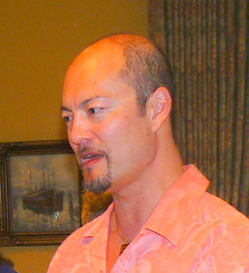When I wrote a guidebook called Touring the Wine Country of Washington back in 1983, it covered every one of the state's 37 wineries. Some 25 years later, Steve Roberts's Wine Trails of Washington has entries for 228, but that's still fewer than half the bonded production facilities that the Feds count as "wineries." For more, see The Bottle Is Passed.
The industry's growth is astonishing: hundres of new wineries, thousands upon thousands of additional vineyard acres, and dozens of new grape varieties.
 The Seattle Wine Awards, a competition open to all Washington and Oregon wineries, is now in its fifth year. Its founder and executive director, Christopher Chan (who is also wine & spirits director at the Rainier Club), assembled an impressive panel of 15 judges (sommeliers, retailers, writers, educators) who gave gold and double gold medals to dozens of wines but steered clear of naming a single, overall "best of show." (The Washington Wine Awards, a separate competition, named Barnard Griffin's 2008 Cabernet Sauvignon the state's outstanding wine.)
The Seattle Wine Awards, a competition open to all Washington and Oregon wineries, is now in its fifth year. Its founder and executive director, Christopher Chan (who is also wine & spirits director at the Rainier Club), assembled an impressive panel of 15 judges (sommeliers, retailers, writers, educators) who gave gold and double gold medals to dozens of wines but steered clear of naming a single, overall "best of show." (The Washington Wine Awards, a separate competition, named Barnard Griffin's 2008 Cabernet Sauvignon the state's outstanding wine.)
The remarkable story of the Seattle Wine Awards, on the other hand, was the surge to prominence of a relatively obscure grape variety, malbec.
Malbec has been grown in France for centuries. In the Bordeaux regon, it's usually the fourth grape in the blend (after cabernet sauvignon, merlot, and cabernet franc). In the Lot Valley of southwestern France, malbec (locally called auxerrois or cot) makes the "black wine" of Cahors. Transplanted to the high Mendoza desert of Argentina, malbec grapes develop a thicker skin to take advantage of the addtional sunlight and cooler growing conditions at elevations above 3,000 feet, which results in a wine with deeper color, plummy flavors and a smooth, almost velvety texture. In fact, malbec, over the past 20 years, has become Argentina's iconic wine, with many brands available in the mid-teen price range.
And here it is back in vogue again in eastern Washington's vineyards. No longer relegated to the task of rounding out a Bordeaux blend, malbecs are now grown on fewer than 1,000 acres but vinified and bottled by over three dozen wineries. Some are no doubt dull, but the award-winners that I tasted at the Seattle WIne Awards this weekend were stunning, especially the bottles released by Dusted Valley and Otis Kenyon. You need to spend $25 a bottle or so to get the full panoply of fruit flavors like boysenberry, black cherry, raspberry, and woody aromas like cedar, cinnamon and chocolate, not to mention the rich, heady notes of black pepper that wine lovers seek (and usually find most readily in wines made from syrah grapes). The malbecs from the 2007 vintage, reaching the shelves now, are simply stunning.
"2007 was a watershed year," says Chan.It wasthe best vintage in a decade for many of Washington's red varieties (cabernet sauvignon, merlot and syrah), but truly a breakout year for malbec.
Leave a comment